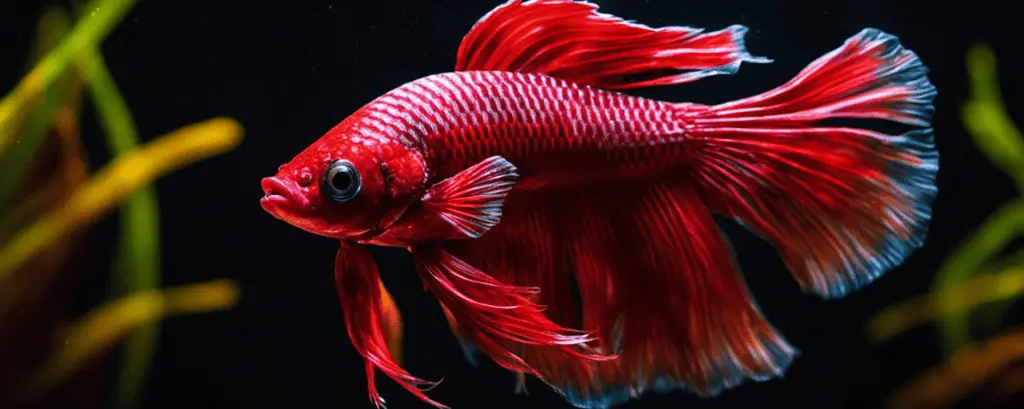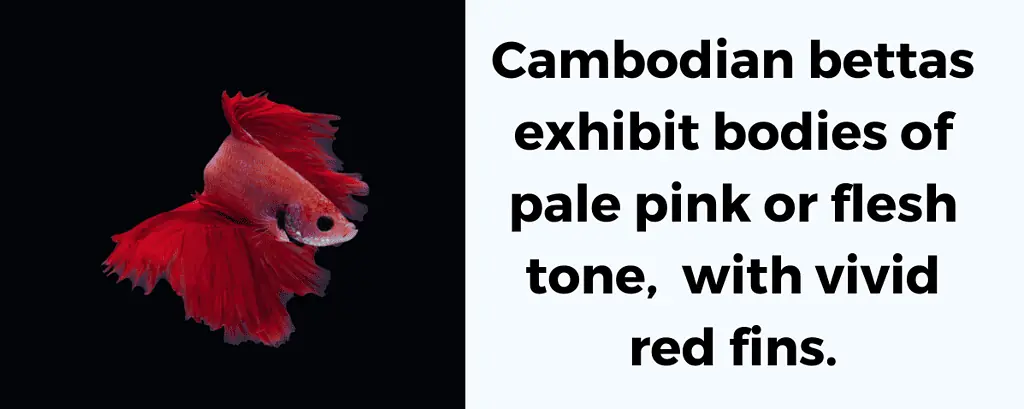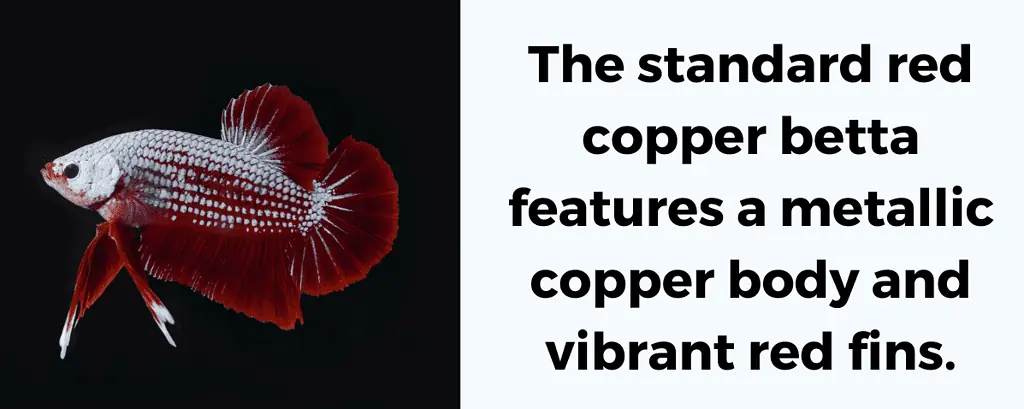Red is the most in-demand color for betta fish.
Even though bettas come in a wide range of colors, a fiery red stands out among the rest.
The popularity of a red betta extends beyond the domestic betta splendens.
Many tropical fish enthusiasts also seek out the wild betta coccina species.
These wild bettas are well-known for their beautiful red color.
In this article, we provide an in-depth look at the red betta and its color variations.
We also discuss why breeding the perfect red betta is so difficult.

Table of Contents
What Is a Red Betta Fish?

Red betta fish can have solid, bi-color, or multi-color patterns.
A bright, cherry red color is usually preferred in these bettas.
Many red bettas have iridescence and a layer of black pigment underneath the scales.
These traits are undesirable for those seeking a betta with perfect red coloring.
Red bettas usually have long fins and tails. The veiltail and halfmoon tail types are the most common in red bettas.
But red bettas can have other tail types, as well. These include:
- Crowntail
- Over halfmoon
- Delta tail
- Super delta tail
- Plakat
- Halfmoon plakat
Red betta fish females have a more subdued red hue and shorter fins than the males.
The wild-type betta coccina, or scarlet betta, looks much different from the betta splendens.
This species is also a less aggressive fish than the betta splendens.
Unlike the betta splendens, more than one betta coccina can live in the same fish tank.
Wild scarlet bettas have a wine-red color with short fins like the plakat species.
Male scarlet bettas sometimes have a greenish-blue spot on their sides.
Color Variations
A solid color on the body and fins is a desirable trait in betta fish.
But breeders developed several brilliant color variations in red bettas through selective breeding.
Some of these color variations are rare despite their popularity.
Cambodian

Cambodian bettas have pale pink or flesh-colored bodies and bright red fins.
Newer Cambodian variants may also have blue or green fins instead of red, but these are rare.
The Cambodian betta color variant originated in the early 1900s.
But the original genetics of the Cambodian betta became diluted when breeders used these fish for developing other color variants.
Finding a true Cambodian betta today is difficult, as this variant is rare.
Red Copper

Red copper bettas come in two variations of their own.
A regular red copper betta has a metallic copper body with bright red fins.
The koi red copper betta has a red, black, and white koi pattern on the body and fins with a metallic copper sheen.
Breeders developed red copper bettas by crossing the betta splendens with the betta imbellis species.
Most red copper bettas have plakat tails and fins. Crowntail and halfmoon red copper bettas also exist, but they are uncommon.
Red Dragon

Red dragon betta fish have thick white body scales with a metallic sheen.
The tail and fins of a red dragon betta are a vivid red color.
Plakat and halfmoon tail types are the most common in this color variation.
These red and white betta fish also go by the names “red snow dragon” and “red platinum dragon.”
Bettas with the dragon scale trait is rare, making red dragon bettas more expensive than other color patterns.
Hellboy

A Hellboy betta has a vivid red color covering most of the body and fins with either black, white, or blue marbling.
The Hellboy betta usually has the plakat or halfmoon plakat tail type.
Hellboy bettas with only black, white, and red colors are more desirable than those with any blue markings.
This color variation is a recent development and is not as common as other color variations.
Are Red Betta Fish Rare?

Red is one of the most common colors in the domestic betta splendens.
You may find several solid or red multi-colored bettas at your local pet store.
But true red bettas without iridescence or black coloring are very rare.
Breeding a red betta without these traits is a challenging task.
Even now, breeders have not developed a perfect red betta.
The wild betta coccina is also a rare species.
Wild bettas live in Southeast Asia. You may find these fish in rice paddies, marshes, and slow-moving streams.
But the betta coccina’s natural habitat is threatened by pollution and destruction.
Because of its habitat loss, the betta coccina is considered an endangered species in the wild.
Captive-bred betta coccinas are more common thanks to a handful of dedicated breeders.
The Average Cost of a Red Betta Fish
The price of a red betta splendens ranges anywhere from $5 to $40, depending on the pattern.
Solid red veiltail males are the least expensive, and the red copper variation costs the most.
A wild-type betta coccina has the highest price at $60 or more.
You may likely find solid or bi-color red betta splendens at your local pet store.
But more elaborate red color variations and the scarlet betta coccina are usually only available from online breeders.
When buying a betta from an online breeder, you must also factor in the shipping costs.
The average shipping cost for bettas is between $15 and $20.
The Breeding History of Red Betta Fish
Most species of wild betta splendens have dull green or brown colors.
Hundreds of years ago, people were not concerned with the color of these fish.
Bettas in Southeast Asia were bred only for fish fighting.
Once the betta made its way to the United States in the early 1900s, selective breeding for bright colors and flashy tail types began in earnest.
Red was one of the first colors breeders developed, and it is still one of the most popular betta colors.
Common Issues with Breeding Red Bettas

Betta fish breeding is not as straightforward as you might think.
There are four layers of pigment cells in domestic bettas:
- Iridescent layer (top)
- Black layer
- Red layer
- Yellow layer (bottom)
A betta’s color depends on pigment cells in each different layer working together.
For example, red bettas with the blonde/bright gene have a paler red color than those without it.
There are three types of red pigment cells in the red layer:
- Extended red
- Reduced red
- Non-red
Extended red cells create a red color on a betta’s body and tail.
Reduced red cells place a red color only on a betta’s fins and tail.
This is a common trait in bettas with the Cambodian color pattern.
Non-red is the absence of red color and results in yellow and orange bettas.
Red Development in Betta Fry

The red coloration does not always show up right away in betta fry.
First, the fins and tail develop red streaks of color.
Once the red pigment fills the fins and tail, the young bettas appear as traditional Cambodian colors.
Next, the red pigment spreads to the betta’s body.
How fast the red pigment develops determines the intensity of the hue.
Bettas with the reddest early on usually have the brightest coloring.
Those with a gradual reddening may have a paler, satin-red color.
This reddening process can take several weeks.
A betta breeder does not know the outcome of their red betta spawn until the fry becomes adult fish.
Breeding the Perfect Red Betta

Betta fish enthusiasts are in constant pursuit of the perfect red betta.
The ideal red betta should carry extended red genes without iridescence or black scales.
But most extended red lines have some form of iridescence.
This iridescence results from breeders crossing red bettas with iridescent bettas for better finnage.
Breeders must remove the black scales and iridescence while maintaining a bright red color.
Crossing an extended red betta with a Cambodian betta removes any black coloring.
But this results in a red betta with a paler body.
Introducing the blonde gene creates a brighter red but does not remove the black pigment.
Removing iridescence is even more of a challenge.
Breeders must cross their extended red bettas with those with the least iridescence.
It can take many generations until the iridescent genes are removed from a line.


